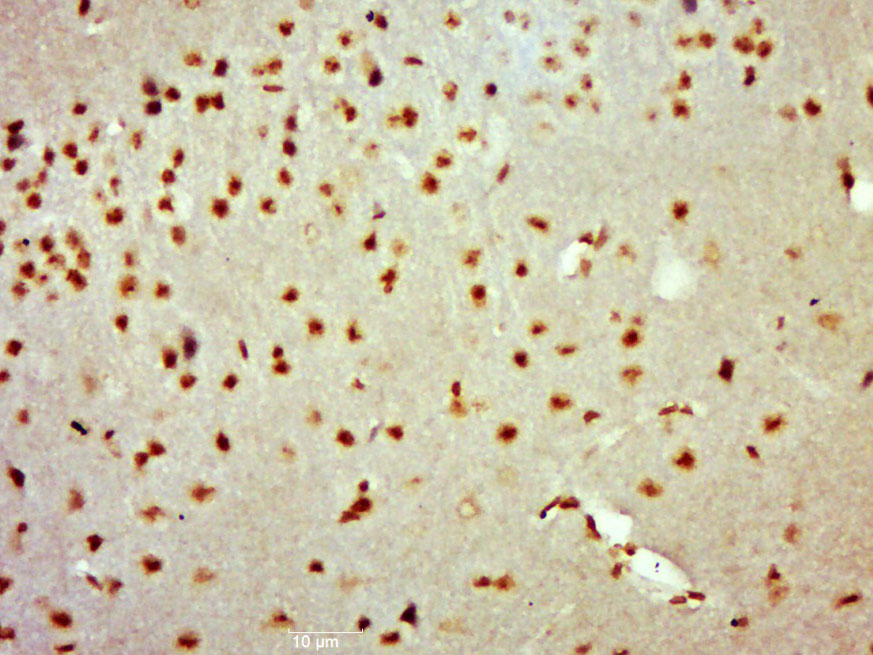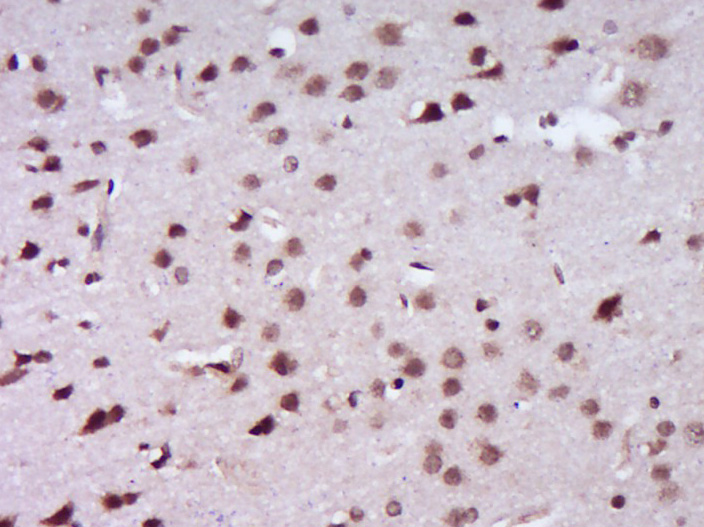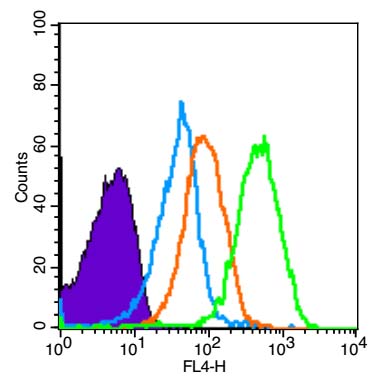
Rabbit Anti-BRCA1 antibody
BRCA 1; BRCA1; BRCA1/BRCA2 containing complex subunit 1; BRCA1/BRCA2-containing complex, subunit 1; BRCA1_MOUSE; BRCAI; BRCC 1; BRCC1; Breast and ovarian cancer susceptibility protein 1; Breast Cancer 1; Breast Cancer 1 Early Onset; Breast cancer type 1 s
View History [Clear]
Details
Product Name BRCA1 Chinese Name 乳腺癌易感基因1抗体 Alias BRCA 1; BRCA1; BRCA1/BRCA2 containing complex subunit 1; BRCA1/BRCA2-containing complex, subunit 1; BRCA1_MOUSE; BRCAI; BRCC 1; BRCC1; Breast and ovarian cancer susceptibility protein 1; Breast Cancer 1; Breast Cancer 1 Early Onset; Breast cancer type 1 susceptibility protein; BROVCA1; IRIS; PNCA4; PPP1R53; Protein phosphatase 1 regulatory subunit 53; PSCP; RING finger protein 53; RING finger protein 53; RNF53; BAP1. literatures Research Area Tumour Cell biology immunology Chromatin and nuclear signals Epigenetics Immunogen Species Rabbit Clonality Polyclonal React Species Mouse, Rat, Applications ELISA=1:5000-10000 IHC-P=1:100-500 IHC-F=1:100-500 Flow-Cyt=3ug/Test IF=1:100-500 (Paraffin sections need antigen repair)
not yet tested in other applications.
optimal dilutions/concentrations should be determined by the end user.Theoretical molecular weight 199kDa Cellular localization The nucleus Form Liquid Concentration 1mg/ml immunogen KLH conjugated synthetic peptide derived from mouse BRCA1: 64-160/1812 Lsotype IgG Purification affinity purified by Protein A Buffer Solution 0.01M TBS(pH7.4) with 1% BSA, 0.03% Proclin300 and 50% Glycerol. Storage Shipped at 4℃. Store at -20 °C for one year. Avoid repeated freeze/thaw cycles. Attention This product as supplied is intended for research use only, not for use in human, therapeutic or diagnostic applications. PubMed PubMed Product Detail This gene encodes a nuclear phosphoprotein that plays a role in maintaining genomic stability, and it also acts as a tumor suppressor. The encoded protein combines with other tumor suppressors, DNA damage sensors, and signal transducers to form a large multi-subunit protein complex known as the BRCA1-associated genome surveillance complex (BASC). This gene product associates with RNA polymerase II, and through the C-terminal domain, also interacts with histone deacetylase complexes. This protein thus plays a role in transcription, DNA repair of double-stranded breaks, and recombination. Mutations in this gene are responsible for approximately 40% of inherited breast cancers and more than 80% of inherited breast and ovarian cancers. Alternative splicing plays a role in modulating the subcellular localization and physiological function of this gene. Many alternatively spliced transcript variants, some of which are disease-associated mutations, have been described for this gene, but the full-length natures of only some of these variants has been described. A related pseudogene, which is also located on chromosome 17, has been identified. [provided by RefSeq, May 2009].
Function:
E3 ubiquitin-protein ligase that specifically mediates the formation of 'Lys-6'-linked polyubiquitin chains and plays a central role in DNA repair by facilitating cellular responses to DNA damage. It is unclear whether it also mediates the formation of other types of polyubiquitin chains. The E3 ubiquitin-protein ligase activity is required for its tumor suppressor function. The BRCA1-BARD1 heterodimer coordinates a diverse range of cellular pathways such as DNA damage repair, ubiquitination and transcriptional regulation to maintain genomic stability. Regulates centrosomal microtubule nucleation. Required for normal cell cycle progression from G2 to mitosis. Required for appropriate cell cycle arrests after ionizing irradiation in both the S-phase and the G2 phase of the cell cycle. Involved in transcriptional regulation of P21 in response to DNA damage. Required for FANCD2 targeting to sites of DNA damage. May function as a transcriptional regulator. Contributes to homologous recombination repair (HRR) via its direct interaction with PALB2, fine-tunes recombinational repair partly through its modulatory role in the PALB2-dependent loading of BRCA2-RAD51 repair machinery at DNA breaks. Component of the BRCA1-RBBP8 complex which regulates CHEK1 activation and controls cell cycle G2/M checkpoints on DNA damage via BRCA1-mediated ubiquitination of RBBP8 (By similarity). Inhibits lipid synthesis by binding to inactive phosphorylated ACACA and preventing its dephosphorylation.
Subunit:
Heterodimer with BARD1. Part of the BRCA1-associated genome surveillance complex (BASC), which contains BRCA1, MSH2, MSH6, MLH1, ATM, BLM, PMS2 and the MRE11-RAD50-NBN protein (MRN) complex. This association could be a dynamic process changing throughout the cell cycle and within subnuclear domains. Component of the BRCA1-A complex, at least composed of the BRCA1, BARD1, UIMC1, BRCC3, BRE and BABAM1. Interacts (via the BRCT domains) with FAM175A. Interacts (via the BRCT domains) with RBBP8 ('Ser-327' phosphorylated form); the interaction ubiquitinates RBBP8, regulates CHEK1 activation, and involves RBBP8 in BRCA1-dependent G2/M checkpoint control on DNA damage. Associates with RNA polymerase II holoenzyme. Interacts with SMC1A and COBRA1. Interacts (via BRCT domains) with BRIP1 (phosphorylated form). Interacts with FANCD2 (ubiquitinated form). Interacts with BAP1. Interacts with DCLRE1C and CLSPN. Interacts with H2AFX (phosphorylated on 'Ser-140'). Interacts with CHEK1 and CHEK2. Interacts with BRCC3. Interacts with AURKA. Interacts with UBXN1. Part of a trimeric complex containing BRCA1, BRCA2 and PALB2. Interacts directly with PALB2; the interaction is essential for its function in HRR. Interacts directly with BRCA2; the interaction occurs only in the presence of PALB2 which serves as the bridging protein. Interacts (via the BRCT domains) with LMO4; the interaction represses the transcriptional activity of BRCA1. Interacts with KIAA0101/PAF15 (By similarity). Interacts (via the BRCT domains) with ACACA (phosphorylated form); the interaction prevents dephosphorylation of ACACA.
Subcellular Location:
Nucleus. Chromosome. Note=Localizes at sites of DNA damage at double-strand breaks (DSBs); recruitment to DNA damage sites is mediated by the BRCA1-A complex.
Tissue Specificity:
In the embryo, expressed in otic vesicles at day 9.5. At day 10.5, this expression decreases and high levels are found in the neuroectoderm. At days 11-12.5, high levels in differentiating keratinocytes and whisker pad primordia. At days 14-17, expression also observed in kidney epithelial cells. In the adult, highest levels found in spleen, thymus, lymph nodes, epithelial organs, and alveolar and ductal epithelial cells of the mammary gland. Very low levels in brain, kidney, and skin. No expression in heart, liver or lung.
Post-translational modifications:
Phosphorylated in response to IR, UV, and various stimuli that cause checkpoint activation, probably by ATM or ATR. Phosphorylation at Ser-971 by CHEK2 regulates mitotic spindle assembly (By similarity).
Autoubiquitinated, undergoes 'Lys-6'-linked polyubiquitination. 'Lys-6'-linked polyubiquitination does not promote degradation (By similarity).
DISEASE:
Defects in BRCA1 are a cause of susceptibility to breast cancer (BC) [MIM:114480]. A common malignancy originating from breast epithelial tissue. Breast neoplasms can be distinguished by their histologic pattern. Invasive ductal carcinoma is by far the most common type. Breast cancer is etiologically and genetically heterogeneous. Important genetic factors have been indicated by familial occurrence and bilateral involvement. Mutations at more than one locus can be involved in different families or even in the same case. Note=Mutations in BRCA1 are thought to be responsible for 45% of inherited breast cancer. Moreover, BRCA1 carriers have a 4-fold increased risk of colon cancer, whereas male carriers face a 3-fold increased risk of prostate cancer. Cells lacking BRCA1 show defects in DNA repair by homologous recombination.
Similarity:
Contains 2 BRCT domains.
Contains 1 RING-type zinc finger.
SWISS:
P38398
Gene ID:
672
Database links:Entrez Gene: 672 Human
Entrez Gene: 12189 Mouse
Omim: 113705 Human
SwissProt: P38398 Human
SwissProt: P48754 Mouse
Unigene: 194143 Human
BRCA1基因是最早被发现的乳腺癌易感基因其突变和家族性乳腺癌、卵巢癌的发病有关。Product Picture
Primary Antibody (green line): Rabbit Anti-BRCA1 antibody (SL0803R)
Dilution: 3μg /10^6 cells;
Isotype Control Antibody (orange line): Rabbit IgG .
Secondary Antibody (white blue line): Goat anti-rabbit IgG-AF647
Dilution: 1μg /test.
Protocol
The cells were fixed with 4% PFA (10min at room temperature)and then permeabilized with 90% ice-cold methanol for 20 min at room temperature. The cells were then incubated in 5%BSA to block non-specific protein-protein interactions for 30 min at room temperature .Cells stained with Primary Antibody for 30 min at room temperature. The secondary antibody used for 40 min at room temperature. Acquisition of 10,000 events was performed.
Bought notes(bought amounts latest0)
No one bought this product
User Comment(Total0User Comment Num)
- No comment





 +86 571 56623320
+86 571 56623320
 +86 18668110335
+86 18668110335

